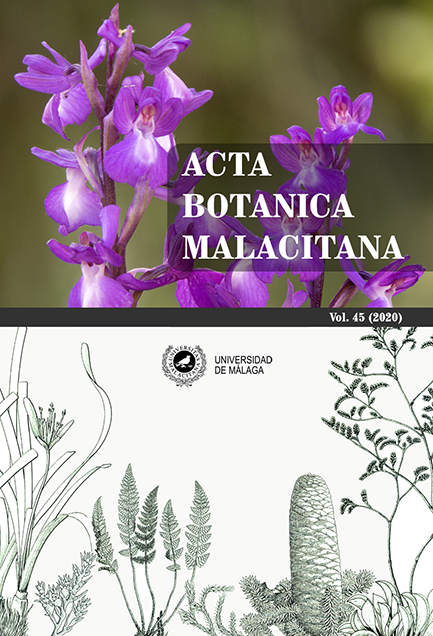First record of the invasive species Caulerpa cylindracea Sonder (Caulerpaceae, Chlorophyta) from Chafarinas Islands (N Africa)
DOI:
https://doi.org/10.24310/abm.v45i.6781Keywords:
conservation, invasive species, Alboran Sea, marine reserveAbstract
The Chafarinas Islands constitute an important biodiversity area in the Alboran Sea (western Mediterranean) that is under protection. For the islands, we present a new record of Caulerpa cylindracea, an aggressive, fast-spreading invasive taxon introduced into the Mediterranean Sea a few years ago. We warn about a potential invasion in this significant marine reserve.
Downloads
Metrics
References
Altamirano, M. (1999). Nuevas citas para la flora marina del archipiélago de las islas Chafarinas. Acta Botanica Malacitana, 24, 185-233.
Altamirano, M., De la Rosa, J., Zanolla, M., Souza-Egipsy, V. & Díaz, J. (2010). New records for the benthic marine flora of Chafarinas islands (Alboran Sea, Western Mediterranean). Acta Botanica Malacitana, 35, 165-167.
Altamirano, M., De la Rosa, J., Flagella, M. & Zanolla, M. (2013). Contributions to the benthic marine flora of Chafarinas Islands (Alboran Sea, Western Mediterranean). Acta Botanica Malacitana, 38, 187-191.
Bouiadjra, B.B., Taleb, M.Z., Marouf, A, Benkada, M.Y. & Riadi, H. (2010). First record of the invasive alga Caulerpa racemosa (Caulerpales, Chlorophyta) in the Gulf of Arzew (western Algeria). Aquatic Invasions, 5, 97-101.
Carlton, J.T. (1989). Man’s role in changing the face of the ocean: biological invasions & implications for conservation of near-shore environments. Conservation Biology, 3, 265–273.
Conde, F. (1984). Contribución al conocimiento de la flora algal bentónica del Mar de Alborán. Islas Chafarinas. Acta Botanica Malacitana, 9, 41-46.
Consejería de Medio Ambiente y Ordenación del Territorio (2015). Programa de Gestión Sostenible del Medio Marino Andaluz - Informe 2015. Junta de Andalucía.
De la Rosa, J., Altamirano, M. & Zanolla, M. (2013). Checklist of benthic marine cyanoprokariota of Chafarinas Islands (Alboran Sea, Western Mediterranean). Acta Botanica Malacitana, 38, 182-186.
European Nature Information System (5 abril 2019). Islas Chafarinas. Site Natura 2000 (ES6300001). https://eunis.eea.europa.eu/sites/ES6300001
Gennaro, P. & Piazzi, L. (2011). Synergism between two anthropic impacts: Caulerpa racemosa var. cylindracea invasion and seawater nutrient enrichment. Marine Ecology Progress Series, 427, 59-70.
Klein, J. & Verlaque, M. (2008). The Caulerpa racemosa invasion: a critical review. Marine Pollution Bulletin, 56, 205–225.
Olson, D.M. & Dinerstein, E. (2002). The Global 200: Priority ecoregions for global conservation. Annals of the Missouri Botanical Garden, 89, 125-126.
Rivera-Ingraham, G.A., García-Gómez, J.C. & Espinosa, F. (2010). Presence of Caulerpa racemosa (Forsskål) J. Agardh in Ceuta (Northern Africa, Gibraltar Area). Biological Invasions, 12(6), 1465–1466.
Simberloff, D., Martin, J.L., Genovesi, P. & al. (2013). Impacts of biological invasions: what's what and the way forward. Trends in Ecology and Evolution, 28, 58-66.
Streftaris, N. & Zenetos, A. (2006). Alien Marine Species in the Mediterranean - the 100 ‘Worst Invasives’ and their Impact. Mediterranean Marine Science, 7, 87-118.
Verlaque, M. (1994). Inventaire des plantes introduites en Méditerranée: origines et répercussions sur l’environnement et les activités humaines. Oceanologica Acta, 17, 1–23.
Verlaque, M., Ruitton, S., Mineur F. & Boudouresque, C.F. (2015). CIESM Atlas of Exotic Species in the Mediterranean. Volume 4. Macrophytes.
Watson, J.E.M, Dudley, N., Segan, D.B. & Hockings, M. (2014). The performance and potential of protected areas. Nature, 515, 67–7.
Downloads
Published
How to Cite
Issue
Section
License
All information related to the licensing of published works in Acta Botanica Malacitana and copyright can be found in our Editorial Policy.







1.png)
